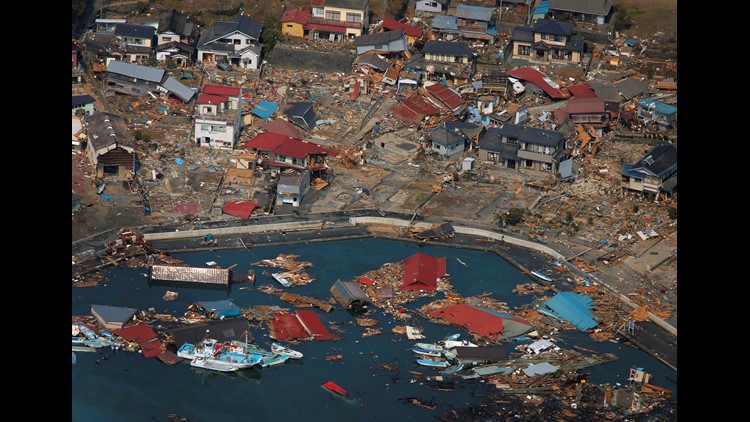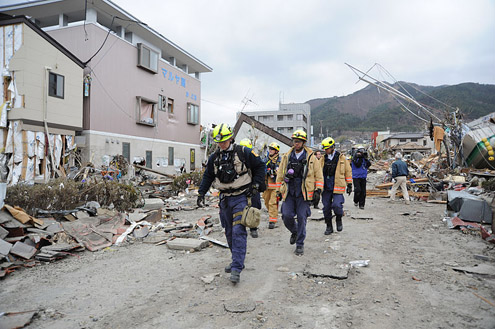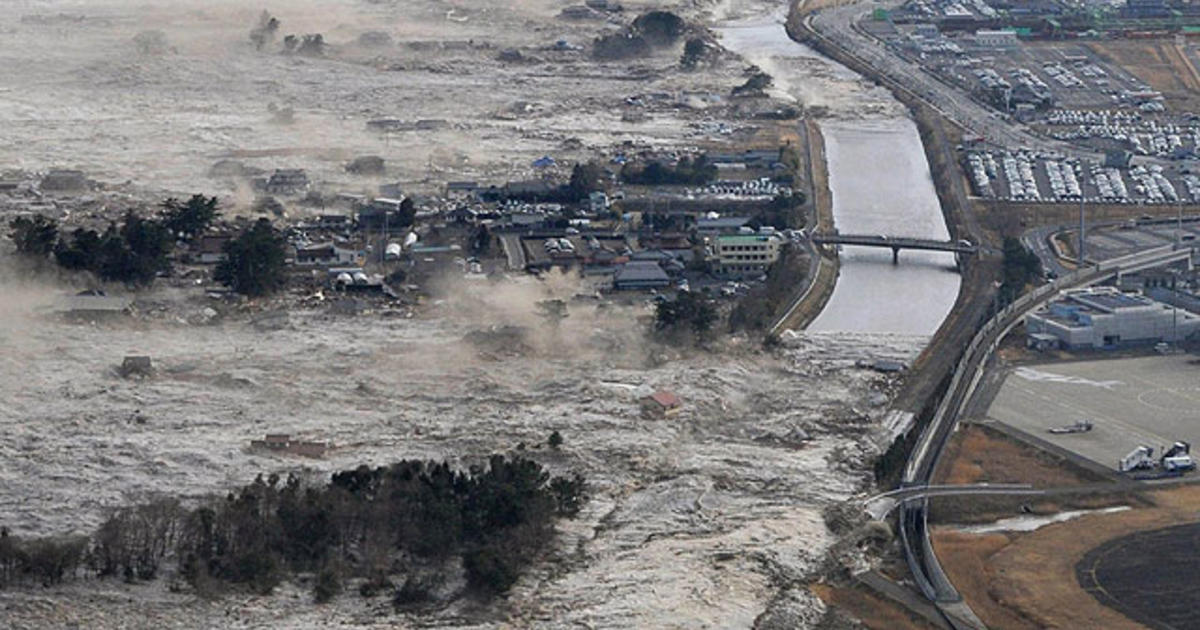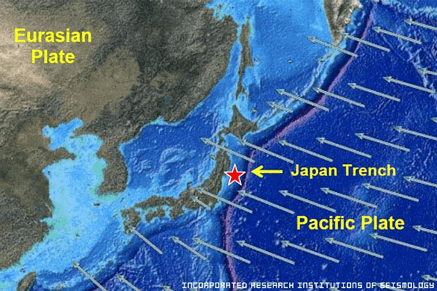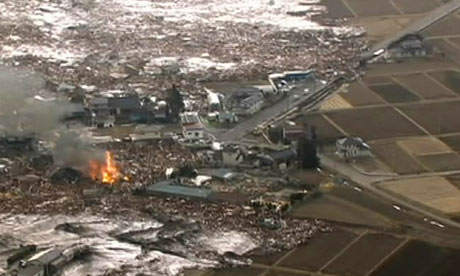Japan Earthquake


This brought the total number of problematic reactors to six. The damaged buildings included 29,500 structures in Miyagi Prefecture, 12,500 in Iwate Prefecture and 2,400 in Fukushima Prefecture. Whatever the eventual outcome, this will be considered one of the earliest examples of a complex megadisaster, where a major, life-threatening industrial or infrastructure failure has combined with a natural catastrophe. This calculation is, in turn, based on the maximum amplitude of the seismic wave. Japan's scientists had forecast a smaller earthquake would strike the northern region of Honshu, the country's main island. Four days later on 11 April, another struck Fukushima, causing additional damage and killing a total of three people. The earthquake was caused by the rupture of a stretch of the associated with the , which separates the from the subducting. Most of these deaths occurred during the first six months after the earthquake and the number dropped thereafter, but as time has passed, the number has continued to increase. But don't worry-you won't notice the difference. Oftentimes there are interventions that can reduce or soften some of these mental health effects. readiness for the possibility of a catastrophic nuclear power plant accident and to underscore the particular failure to protect children by appropriate availability of potassium iodide KI needed to prevent cancer in those who could be exposed to a radioactive iodine. Service between Tokyo and was restored by May, but at lower speeds due to ongoing restoration work; the pre-earthquake timetable was not reinstated until late September. The volcano had previously erupted in January 2011; it is not known if the later eruption was linked to the earthquake. 5 in per year, dips under Honshu's underlying plate, building large amounts of. " Checks were still being carried out to determine the number injured, he said, urging people not to venture outdoors and to be prepared for aftershocks. As these massively destructive and costly events become more frequent, scientific evidence points to climate change as a leading cause. 8 due to the redistribution of Earth's mass. In the fall of 2016 Japan's National Research Institute for Earth Science and Disaster Resilience NIED; Japanese abbreviation, Bosai Kaken; full name Bousai Kagaku Gijutsu Kenkyusho launched the online interactive "Disaster Chronology Map for Japan, 416—2013" map labels in Japanese to display in visual form the location, disaster time, and date across the islands. Writer Caryl-Sue, National Geographic Society Producer Caryl-Sue, National Geographic Society Last Updated April 6, 2020• The inundated areas closely matched those of the. The tsunami caused , primarily the at three reactors in the complex, and the associated evacuation zones affecting hundreds of thousands of residents. Just over an hour after the earthquake at 15:55 JST, a tsunami was observed flooding , which is located near the coast of , with waves sweeping away cars and planes and flooding various buildings as they traveled inland. is a fossil that forms when silica replaces and infills the cavities of wood. According to a special committee on disaster prevention designated by the Japanese government, the tsunami protection policy had been intended to deal with only tsunamis that had been scientifically proved to occur repeatedly. The Tsukuba control center resumed full operations for the space station's Kibo laboratory and the HTV cargo craft on 21 March 2011. According to a 2020 study, "the earthquake and its aftermaths resulted in a 0. Psychological first aid can be made available to responders and survivors who may be affected by what they have witnessed and experienced, and more advanced therapeutic measures can be offered to those suffering acute, clinical reactions. For information on user permissions, please read our. It is clear that the probability of such a disaster is low, but the events in Japan have demonstrated that we must be prepared for a range of disasters we would hope never occur. Of the total confirmed victims, 14,308 drowned, 667 were crushed to death or died from internal injuries, and 145 perished from burns. At least four people were killed, and electricity was cut off across much of northern Japan including the loss of external power to and. 0 M w as reported by the Japanese Meteorological Agency. Over eight hundred aftershocks of magnitude 4. 8 earthquake in Chile, Gross estimated the Chile quake should have shortened the length of day by about 1. key-facts-element:not :last-child p,. Four dams within the quake area were unreachable. animate-line:not :last-of-type :after,. 5 metres 11 ft• key-facts-element:last-of-type,. The plant was shut down as a precaution. In addition to Sendai, other hard-hit by the tsunami included and in Iwate; , , and in Miyagi; and and in Ibaraki. The areas flooded in 2011 closely matched those of a tsunami that hit Sendai in 869. The public and other companies were also encouraged to conserve electricity in the 2011 summer months. from "deaths" template• His calculations indicate that by changing the distribution of Earth's mass, the Japanese earthquake should have caused Earth to rotate a bit faster, shortening the length of the day by about 1. 8 microseconds and shifted Earth's figure axis by about 7 centimeters, or 2. Because tsunami walls had been overtopped, the committee also suggested, besides building taller tsunami walls, also teaching citizens how to evacuate if a large-scale tsunami should strike. Learn more about environmental hazards with this curated resource collection. Because the plate boundary and in the area of the Honshu rupture is not very straight, it is unusual for the magnitude of its earthquake to exceed 8. The plant's three reactors automatically shut down without damage and all safety systems functioned as designed. The earthquake and tsunami also caused extensive and severe structural damage in north-eastern Japan, including heavy damage to roads and railways as well as fires in many areas, and a dam collapse. Port of — 5 metres 16 ft• The environmental hazards you face depend on where you live. The tsunami raced outward from the epicentre at speeds that approached about 500 miles 800 km per hour. " Measurement Limitations Gross said that while we can measure the effects of the atmosphere and ocean on Earth's rotation, the effects of earthquakes, at least up until now, have been too small to measure. The March 11 earthquake started on a Friday at 2:46 p. Emergency vehicles staging in the ruins of , Japan following the tsunami According to Japan's foreign ministry, 116 countries and 28 international organizations offered assistance. The Rights Holder for media is the person or group credited. Kato said the plant was being inspected but there was "no concern of a damage-causing tsunami" and "no anomalies" had been reported at the site. "There have been no anomalies reported from any of the nuclear facilities," Japanese Prime Minister Yoshihide Suga told a press conference. Because of , such changes of result in small changes to the Earth's rate of rotation. The ship started its journey in Hokkaido. In Sendai, a 145,000-barrel 23,100 m 3 -per-day refinery owned by the largest refiner in Japan, , was also set ablaze by the quake. The axial shift was caused by the redistribution of mass on the Earth's surface, which changed the planet's. Researchers sailed offshore and line to measure the forces that caused the earthquake. An official in the city's government trash disposal department estimated that it would take three years to empty these sites. However, these scales "saturate" for earthquakes that are above a certain magnitude magnitude 8 on the JMA scale ; that is, in the case of very large earthquakes, the scales' values change little despite large differences in the earthquakes' energy. With damage to so many power plants, it was feared it might be years before a long-term solution could be found. 26 microseconds and shifted Earth's figure axis by about 8 centimeters 3 inches. 7;-webkit-box-shadow:0 0 50px rgba 0,0,0,. 25em;color: fff;background-color:rgba 0,0,0,. The warning for the general public was delivered about 8 seconds after the first was detected, or about 31 seconds after the earthquake occurred. The largest individual recording in Japan was 2. According to some reports, one wave penetrated some 6 miles 10 km inland after causing the Natori River, which separates Sendai from the city of Natori to the south, to overflow. Teams studied the tsunami deposits to better understand ancient sediment records of the deadly waves. A wave measuring some 33 feet high inundated the coast and flooded parts of the city of , including its airport and the surrounding countryside. from the original on 15 March 2011. 0 earthquake struck at 2:46 pm. The tsunami swept the Japanese mainland and killed over 15,000 people, mainly through drowning, though blunt trauma also caused many deaths. Damage to the antenna of The of the seismic waves from the earthquake was calculated to be 1. Tsunami flooding on the runway Large parts of and the southern section of including the port area were almost entirely destroyed. Course material was developed by the National Center for Disaster Preparedness in collaboration with the This training provides a basic overview of the public health risks of ionizing radiation. At least 101 designated tsunami evacuation sites were hit by the wave. 875em;display:-webkit-inline-box;display:-webkit-inline-flex;display:-ms-inline-flexbox;display:inline-flex;-webkit-box-align:center;-webkit-align-items:center;-ms-flex-align:center;align-items:center;-webkit-box-pack:center;-webkit-justify-content:center;-ms-flex-pack:center;justify-content:center;font-weight:700;-webkit-border-radius:5px;border-radius:5px;cursor:pointer;line-height:1;border:none;-webkit-box-sizing:border-box;box-sizing:border-box;-webkit-transition:all. Buildings destroyed by the tsunami released thousands of tons of ozone-destroying chemicals and greenhouse gases into the air. JMA also implemented a simpler empirical method to integrate, into a tsunami warning, data from GPS tidal meters as well as from undersea water pressure meters, and there are plans to install more of these meters and to develop further technology to utilize data observed by them. are normally elaborate Buddhist ceremonies that entail cremation. Archived from on 1 April 2011. Archived from on 28 July 2011. The Japan Meteorological Agency said the quake — which it initially said had a magnitude of 7. 8 ft surge which arrived 20 hours after the earthquake, after the tsunami warning had been lifted. It is the active thyroid glands of growing humans that rapidly absorb radioactive iodine which, once there, can result in significant increases in thyroid cancer later in life. Follow Becky Oskin. In Tokyo, there was damage to , , , and the walls of. 9 trillion yen , according to the Japanese government. These environmental hazards shape human activity regionally. The single crematorium in , for example, could only handle four bodies a day, although hundreds were found there. Overseas The tsunami was reported to have caused several deaths outside Japan. Water column height on 11 March 2011 at Station, 690 NM southeast of Tokyo The earthquake took place at 14:46 JST UTC 05:46 around 67 kilometres 42 mi from the nearest point on Japan's coastline, and initial estimates indicated the tsunami would have taken 10 to 30 minutes to reach the areas first affected, and then areas farther north and south based on the geography of the coastline. The early estimate of magnitude 8. RELATED TRAINING RESOURCES Dr. National Police Agency of Japan. This map shows the travel times of the tsunami generated by the Honshu earthquake on March 11, 2011. A surge of displaced and fearful people will likely move in to surrounding areas seeking food, shelter, and help. More power plants are seen around the Great Lakes and in the Northeast with a higher occurrence of populations which overlap within the 50 mile catchment of multiple nuclear plants. Seismic hazard is displayed as Peak Ground Acceleration PGA ; the greater the PGA, the greater objects will accelerate horizontally thusly experiencing a greater force. Also, observed data from tidal meters that were located off the coast were not fully reflected in the second warning. The M 0 , which represents a physical size for the event, was calculated by the USGS at 3. - a light-colored extrusive igneous rock intermediate between rhyolite and andesite. 2 ;box-shadow:0 0 50px rgba 0,0,0,. An analyst estimates that consumption of various types of oil may increase by as much as 300,000 barrels 48,000 m 3 per day as well as LNG , as back-up power plants burning try to compensate for the loss of 11 GW of Japan's nuclear power capacity. 7 g, in Miyagi Prefecture, 75 km from the epicentre; the highest reading in the Tokyo metropolitan area was 0. This 12 minute training is conducted by , RN DrPH, Senior Investigator and Affiliated Faculty of the National Center for Disaster Preparedness, Columbia University The earthquake, tsunami, and nuclear disaster unfolding in Japan demonstrate the need for special skills among international relief workers assisting in the recovery. If you have questions about licensing content on this page, please contact for more information and to obtain a license. Also, many people caught in the tsunami thought they were on high enough ground to be safe. Many people also , or assumed the tsunami would be as small as ones they had previously experienced, the study found. On 7 December 2012 a caused a minor tsunami, and again on 26 October 2013 a small tsunami was recorded after a 7. 2s ease-in-out;transition:all. Researchers soon after the full extent of the disaster was known launched a project to gather all digital material relating to the disaster into an online searchable archive to form the basis of future research into the events during and after the disaster. The of the European Union addressed the European Parliament on 15 March, explaining that the nuclear disaster was an "apocalypse". If you have questions about how to cite anything on our website in your project or classroom presentation, please contact your teacher. 5 inches , towards 133 degrees east longitude. Two months after the earthquake, incorporated the earthquake itself into the story of , the eighth installment of the series; while JoJolion is set several months after the fictional town of Morioh was devastated by the earthquake, the earthquake has a key role in the plot as it is the cause behind the emergence of the Wall Eyes, mysterious stone structures that ultimately set the story into motion. As resources and services in the affected area are destroyed or disrupted, neighboring regions will be compelled to provide some of these goods and services. important;clear:both;font-family:Work Sans,sans-serif;padding:30px! Most of the foreshocks are interplate earthquakes with thrust-type focal mechanisms. 3 metres 24 ft or higher• Further information: Japan experienced over 1,000 aftershocks since the earthquake, with 80 registering over magnitude 6. Fukushima became synonymous with when the area was hit by a 9. Because of the unquestioning nature of most Japanese media to hold to the "party line", many Japanese mid-level officials and experts spoke to foreign media to get their opinions and observations publicized. began on 14 March due to power shortages caused by the earthquake. reports that as many as 100,000 children were uprooted from their homes, some of whom were separated from their families because the earthquake occurred during the school day. Earthquake engineers examined the damage, looking for ways to build buildings more resistant to quakes and tsunamis. By 21 March 2011, the number of households in the north without electricity fell to 242,927. Another cause of delayed evacuations was the release of the second update on the tsunami warning long after the earthquake 28 minutes, according to observations ; by that time, power failures and similar circumstances reportedly prevented the update from reaching some residents. A quake of this magnitude usually has a rupture length of at least 500 km 310 mi and generally requires a long, relatively straight fault surface. Other nationwide Japanese and international TV networks also broadcast uninterrupted coverage of the disaster. Initially, the earthquake caused sinking of part of Honshu's Pacific coast by up to roughly a metre, but after about three years, the coast rose back and kept on rising to exceed its original height. Choose a language from the menu above to view a computer-translated version of this page. Rolling blackouts of approximately three hours were experienced throughout April and May while TEPCO scrambled to find a temporary power solution. The position of Earth's figure axis also changes all the time, by about 1 meter 3. 5 ;background-image:-webkit-linear-gradient rgba 0,56,145,. Japan The issued by the was the most serious on its warning scale; it was rated as a "major tsunami", being at least 3 metres 9. The system automatically stopped all high-speed trains, which minimized the damage. 9 in ", and this value was broadcast throughout the mass media and the warning system, which caused some residents to underestimate the danger of their situation and even delayed or suspended their evacuation. A report by the National Police Agency of Japan on 10 September 2018 listed 121,778 buildings as "total collapsed", with a further 280,926 buildings "half collapsed", and another 699,180 buildings "partially damaged". 46GW during the 2011 summer, 3. The number of aftershocks was associated with decreased health across Japan. As of March 2012, the Japanese government had recognized 1,331 deaths as indirectly related to the earthquake, such as caused by harsh living conditions after the disaster. Run up height, port of area — 24 metres 79 ft• Voluntary reductions in electricity use by consumers in the Kanto area helped reduce the predicted frequency and duration of the blackouts. Miyagi prefecture suffered the greatest losses, with some 10,800 killed or missing and another 4,100 injured. 7-metre tsunami waves struck the coasts of and in. The assigned a magnitude of 7. As of the end of May 2011, residents of Iwate, Miyagi, and Fukushima prefectures had requested deregistration of 15,000 vehicles, meaning that the owners of those vehicles were writing them off as unrepairable or unsalvageable. 0 would take place off the Pacific coast of northeastern Japan, on average, every 600 years. While the water has been treated to remove most of the dangerous radioactive components, traces of tritium remain. 9 M w at 15:15 JST 6:16 UTC and a 7. 5 ;background-image:-o-linear-gradient rgba 0,56,145,. The aftershock on 7 April caused the loss of external power to Rokkasho Reprocessing Plant and Higashidori Nuclear Power Plant but backup generators were functional. In comparison to the , the East Japan earthquake brought serious damage to an extremely wide range. And this critical goal must include comprehensible, feasible, tested and publically acceptable plans to make sure that no child is without immediate access to KI if and when the need arises. 3 metres 11 ft or higher• The country's stringent seismic building codes and early warning system prevented many deaths from the earthquake, by stopping high-speed trains and factory assembly lines. Like the , the damage by surging water, though much more localized, was far more deadly and destructive than the actual quake. This resulted in an underestimation of the tsunami's height in initial reports. in Sendai was also particularly hard hit. Many sections of serving northern Japan were damaged. By summer the Vice-minister for Economy, Trade and Industry, the head of the Nuclear and Industrial Safety Agency, and the head of the Agency for Natural Resources and Energy had all lost their jobs. National Police Agency of Japan. In addition to refining and storage, several power plants were damaged. Hence, earthquakes in this area with magnitudes of about 7 since 1926 had only released part of the accumulated energy. evacuated 11,000 residents from coastal areas of the. Of those who attempted to evacuate after hearing the warning, only five percent were caught in the tsunami. Note: Does not include all radiation readings from Fukushima Daini site The earthquake and the tragic losses had been served as a significant inspiration for the , in which, in the , managed to create the greatest giant-killing ever in the history where Japan came from nothing to become world champions despite the devastating earthquake and lack of funding for the team; the Nadeshiko itself also unveiled banner to thank global support despite adverse situations at home. In Japan, residents are still recovering from the disaster. Worldwide effects The tsunami waves also traveled across the Pacific, reaching Alaska, Hawaii and Chile. By 9:30 UTC on 11 March 2011, , which was previously used in the , , and earthquakes, was collecting information about survivors and their locations. Others halted production due to safety checks and power loss. offshore of central — 6. The March 11 temblor was felt as far away as , Russia; , Taiwan; and , China. from "missing" template• Aerial photo of Minato, devastated by both the earthquake and subsequent tsunami The degree and extent of damage caused by the earthquake and resulting tsunami were enormous, with most of the damage being caused by the tsunami. But Japan's one-two punch proved especially devastating for the earthquake-savvy country, because few scientists had predicted the country would experience such a large earthquake and tsunami. Governments and the military were forced to bury many bodies in hastily dug with rudimentary or no rites, although relatives of the deceased were promised that they would be cremated later. A few cases of suicide are also included. 5 ;background-size:1px 1px;background-repeat:repeat-x;background-position:0 1. [Infographic: ] Scientists drilled into the subduction zone soon after the earthquake and discovered a thin, slippery clay layer lining the fault. Thus, taken before or immediately after absorbing radioactive iodine by inhalation or ingestion, potassium iodide reduces toxic effects on the thyroid. Scientific and research response Seismologists anticipated a very large quake would strike in the same place as the — in the , southwest of Tokyo. The earthquake triggered powerful waves that may have reached heights of up to 40. 1, which killed more than 230,000 people. This motion pushes the upper plate down until the accumulated stress causes a seismic slip-rupture event. and Canadian shores in the ensuing years. Dam failure at Fujinuma The in ruptured, causing flooding and the washing away of five homes. A man who is said to have been attempting to photograph the oncoming tsunami at the mouth of the , south of , was swept out to sea. The temblor completely released between the two tectonic plates, a recent study found. in , Tokyo The Earth's shifted by estimates of between 10 cm 4 in and 25 cm 10 in. Interactives Any interactives on this page can only be played while you are visiting our website. The temblor also shortened the length of a day by about a microsecond. Reportedly, some locals had attempted to repair leaks in the dam before it completely. 1 metres 13 ft or higher• " he March 11, 2011, great earthquake in Japan may have shortened the length of Earth days and shifted its axis. Also, following the earthquake, for the first time in Japanese history, the Emperor addressed the nation in a pre-recorded television broadcast. Both interplate and intraplate earthquakes appeared in the aftershocks offshore Sanriku coast with considerable proportions. Following the main earthquake on 11 March, a 7. A significant leak occurred in August 2013, discharging about 330 tons 300 metric tons of irradiated water into the landscape surrounding the plant. According to the JMA [], reasons for the underestimation include a saturated magnitude scale when using maximum amplitude as input, failure to fully take into account the area of the , and the initial amplitude of the earthquake being less than that which would be predicted by an empirical relationship. It was not as bad as the , but worse than the. Beyond the sympathy and grief we share with Japan and its citizens, there are important observations we in the United States must make. More than 5,000 aftershocks hit Japan in the year after the earthquake, the largest a magnitude 7. Earth's figure axis should not be confused with its north-south axis; they are offset by about 10 meters about 33 feet. 0; a regularly updated map showing all shocks of magnitude 4. Even more helpful may be broad social interventions that assist affected populations in returning to a semblance of normalcy, maintaining normal routines, and engendering a sense of self-efficacy and self-determination rather than helplessness. Warnings were issued and evacuations were carried out in many countries bordering the Pacific. " The cause The struck offshore of Japan, along a subduction zone where two of Earth's tectonic plates collide. This deviation led to a number of small planetary changes, including the , the , and the. In the present Japanese crisis, public health authorities in the US and Canada warn that the side effects for North Americans taking potassium iodide would outweigh its negligible benefits. It should noted that these are the very same issues which need to be incorporated in the disaster planning for any nation, including the U. 0 on the Richter scale, it was one of the most powerful earthquakes ever recorded. More than 120,000 buildings were destroyed, 278,000 were half-destroyed and 726,000 were partially destroyed, the agency said. At Fukushima Daiichi and Daini, tsunami waves overtopped seawalls and destroyed diesel backup power systems, leading to severe problems at Fukushima Daiichi, including three large explosions and radioactive leakage. - A bluish green gem material that has been used for over 6000 years. 75;-webkit-transition:opacity. An expedition named have been conducted in year 2012—2013 to drill oceanfloor boreholes through the fault-zone of the earthquake and gathered important data about the rupture mechanism and physical properties of the fault that caused the huge earthquake and tsunami which devastated much of northeast Japan. A report by the , published in on 2 December 2011, concluded that the seabed in the area between the epicenter and the moved 50 metres 160 ft east-southeast and rose about 7 metres 23 ft as a result of the quake. The committee advised that future policy should be to protect against the highest possible tsunami. 15:20 JST — — 3. Notable exceptions, according to Adelstein, were newspapers and which questioned the accuracy of the information coming from the government and TEPCO. It was preceded by several foreshocks, including a magnitude-7. Some houses along the coast in were destroyed. Noted individual fatalities within Japan included 104-year-old , holder of the world athletics records in the men's shot put, discus throw and javelin throw for the over-100 age category. Investigations were continuing to make sure there was no structural damage, he added. Eleven airliners bound for Narita were diverted to nearby. Unfortunately, the response planning for a potential serious problem, where large amounts of radiation might be released, has been inadequate on many levels. Earthquakes are more common in some parts of the world than others, because some places, like California, sit on top of the meeting point, or fault, of two plates.。 。
